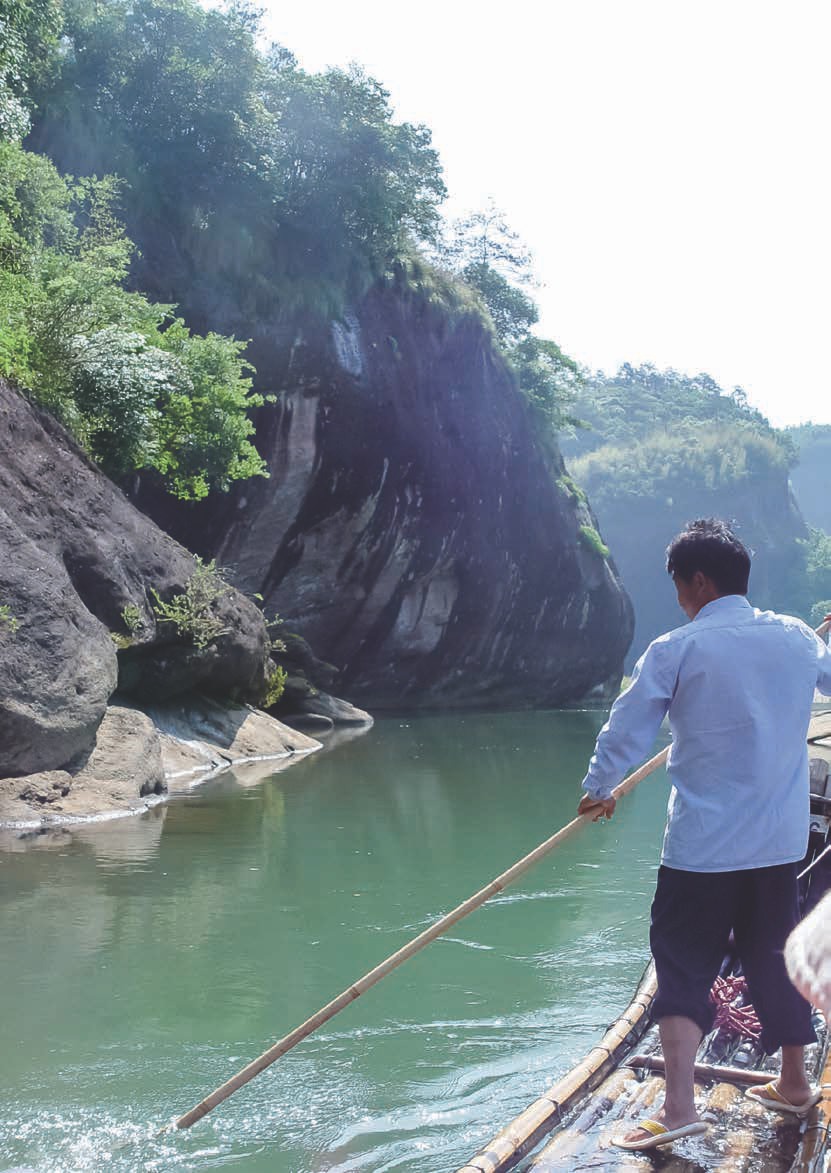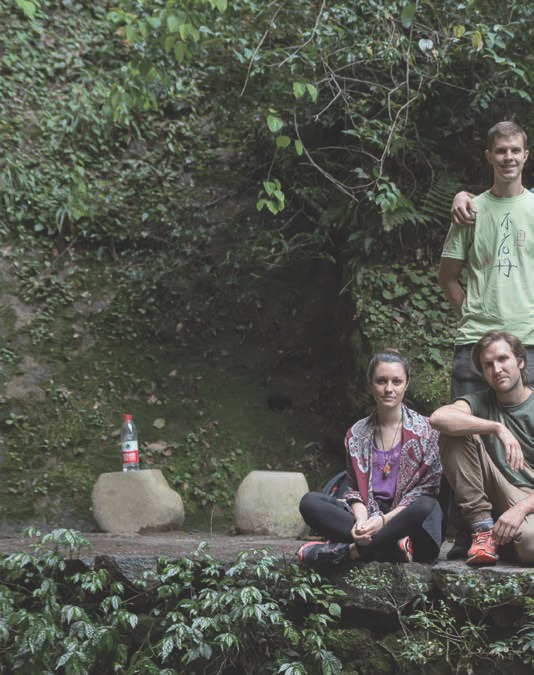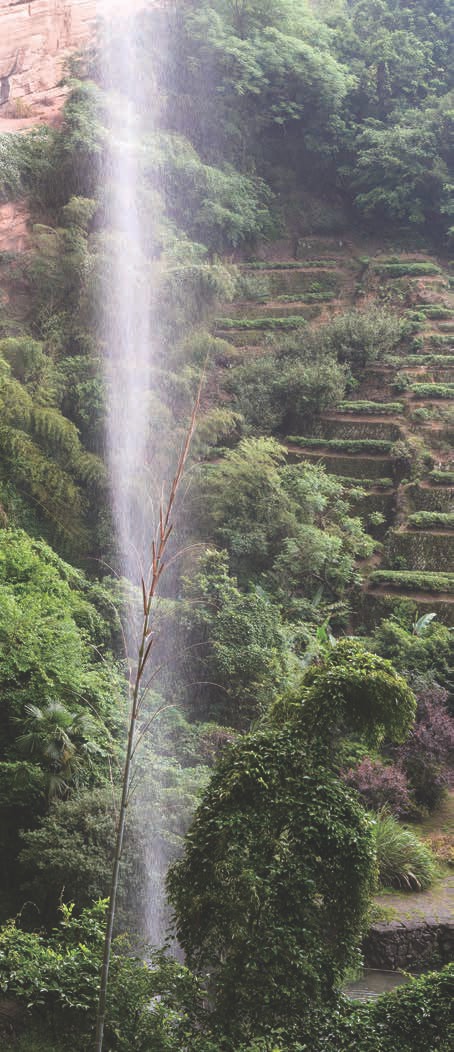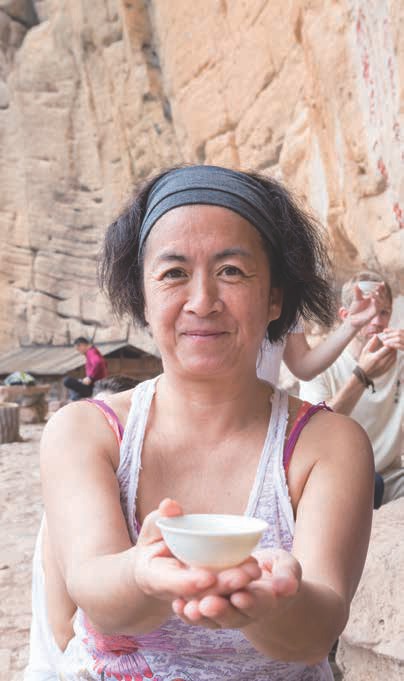
 |
|

Wuyi has a legacy of Nature and cultural heritage that would make any nation proud. The unique landscape is awe-inspiring, leaving one bewildered even after many years of going there. The water is clear and clean like white jade; the thirty-six emerald peaks all reach towards the sky in askance, and ninety-nine different kinds of rock add color and variance to the scenery. The mystical setting, celebrated culture and exquisite tea all make Mt. Wuyi a necessary stop in China.
There are countless places worth visiting in Wuyi, offering an experience of Nature, culture, art and of course tea. The "Hanging Coffins" and "Hong Qiao Ban" were part of the Min Yue people's cultural heritage. They were created more than three thousand years ago. The Min Yue also built a castle around two thousand years ago that still stands to this day. The rock caves of Wuyi were used throughout the Tang, Song, Yuan, Ming and Qing dynasties. Almost any road in Wuyi will lead to some place where Nature meets the sky in a stunning vista-embrace. And no trip to Wuyi would be complete without a look at the production of its renowned Cliff Tea. Recently, the roads in Wuyi have been upgraded, and travel has become much more convenient. The local government is promoting tourism with the hopes that more people will share in all the wonders Wuyi has to offer. Let us take a tour of just a few of the more magnificent places in Wuyi that are worth visiting:
This murmuring river winds around Wuyi between the peaks on the southwest of Mt. Huang Gang - the main peak of the Wuyi Mountain range. The source of the river is high up the peak. The Jiu Qu is said to bend nine times, each with its own unique beauty. There is an old folk saying, "Every turn around the mountain, the peak is reflected in the water," which expresses the elegance of Nature there. By looking upwards one can see the mountains twisting into the blue, and below the same image is delightfully inverted again in the river. The water is clear and clean, and one feels like dipping a hand into the mountains reflected there. Some tourists close their eyes and listen to the riversong, forgetting where they are completely. The first visit to Jiu Qu often leaves one too stunned to even take a photograph.

This castle has several names. It is also referred to as "Ancient Hang Castle" (Gu Yue Castle) and "Ming Wang Castle". It's located just south of the famous Wuyi temple. It is over 48,000 square meters and is the best kept Hang castle in the south of China. The castle was built in 202 BCE when the Duke of Min Yue received his feud from Emperor Han Gao Zu, who was the founder of the Han Dynasty. The railing architecture is very characteristic of the local Min Yue culture. There were also a variety of historical relics discovered in or around the castle. Some were also found in the village next to the castle called "Gu Yue Cheng Village" because of its proximity to the castle. Much of what is known about the Fukien people was augmented by the finds in Wuyi. One feels very special standing on such ancient ground, knowing that a village once flourished beneath the walls of the castle. A trip to the castle will reward one with an understanding of the history and heritage of Wuyi.
Located on the upper reaches of the Jiu Qu River, this primordial forest offers spectacular views of subtropic vegetation beneath Wuyi peaks, deep and serene gorges and beautiful waters. The ecology there is vibrant and colorful enough to make each and every visit a different experience. The Emerald Valley is made up of eighteen ponds in a pallete of colors, and sixty-six gorgeous emerald pools. The most famous of these vibrant waters are the Dreamy Pond and Ox Horn Pool. This park is a kingdom of plants and animals unto itself. It is an ideal place for exploration, repose and adventure.


The National Reservation in Wuyi is one of the five largest in China, spanning more than twenty-thousand hectares. Natural forest covers more than 95% of the park. It is home to several unique species of plant and animal, like the amphibious creeper. It is a heaven for birds, snakes and insects as well as the scientists that study them. In September of 1999 it was added to the "Record of the World's Natural and Cultural Legacy", thereby becoming an internationally protected site. There is so much to see and do in the park that a complete travel book would be needed for it alone. All of the following sights are found within the region of the park known as the Wuyi Scenic Area:
Besides the beautiful panorama offered by Lotus Peak, there is the very interesting Yu Ting Lin Kiln Site. The site was a Song Dynasty pottery village. Hundreds of pieces have been found there dating back roughly a millennium. Most of them are tea sets made with pitchblack glaze. They are bright and clear with a primitive simplicity that is gorgeous nonetheless. The park is about seventeen square kilometers and there are many sights worth visiting there. The Kou Bing Ancient Buddha and Laying Buddha are both very old Chinese representations. At the kiln site one can visit the museum and view the Song tea sets as well as watch modern potters make recreations of these magnificent pieces. One gets the sense that religion and tea have always played a pivotal role in the life of Wuyi people. The environment inspires spiritual hermitage and the growth of tea both, so it's no wonder that they were attracted here even in ancient times.
On the upper reaches of the mountain range, this scenic park will stun the senses in that characteristic Wuyi way. The Qing Long and Feng Huang waterfalls are both dazzling photo opportunities. Anyone who travels here will leave with a sense of breadth and profundity. The way Nature carved out the Red River Valley is almost alien, seemingly sculpted by titan hands before there were men. One can enjoy white water rafting in the river below if one is inclined more towards the excitement and danger of travel. Otherwise, one can just laze around and take pictures of the mountains and waterfalls that abound.
The Dao Yuan caves have always been a solace from the turmoil of the world below. The 10-square-kilometer park offers views of the Tian You, San Ceng and San Yang peaks, the Snow Flower Mountain, Xian Yu and Golden Brick Pools, as well as the Huma Ravine. The caves were once home to Daoist mendicants and still vibrate with the cool tranquility of their meditations.
This area is the largest and longest ravine in the Wuyi scenic area. It gives the impression of an emperor god's great hall, decorated profusely with majestic mountains and water fit for such a king. This part of the park also represents the largest of the scenic spots in Wuyi, covering more than 22 square kilometers. The Shiu Lian cave is cool and beautiful. There are several peaks, ravines and waters in the area worth visiting. And no stop to Wuyi can be complete without a visit to the legendary Da Hong Pao tea trees which are held in a Monastery park. Da Hong Pao is a cliff tree, fed by the spring water that drips down through cave minerals and nourishes the trees in such a unique way. Looking around in a circle, one will understand quite clearly why Da Hong Pao is known as the "King of Tea".
This part of the Scenic Area is on the south of the mountain, near the second bend of the Jiu Qu River. It offers deep draughts of mountain air that seem to be drawn from the sky itself, so close. There is a deep gully flanked by a giant stone named "Lin Yan". In the grottoes nearby there are several caves to explore. One must be sure to go into Fu Xi Cave. Inside the cavern, one can look up past the vast walls and see the dark sky in a line shaped like a rainbow. Nature's uncanny workmanship is why the name "Linear Sky" was bestowed upon this area. It is yet another example of how the gods seemed to sculpt portraits of heaven upon the landscape of Wuyi.




